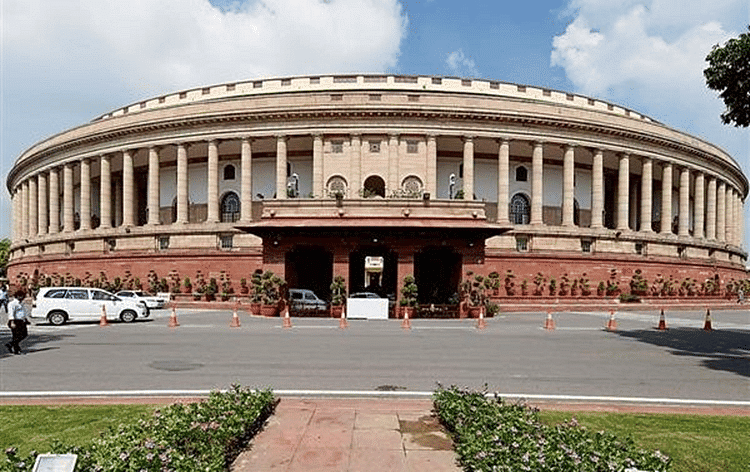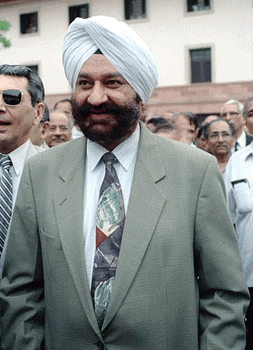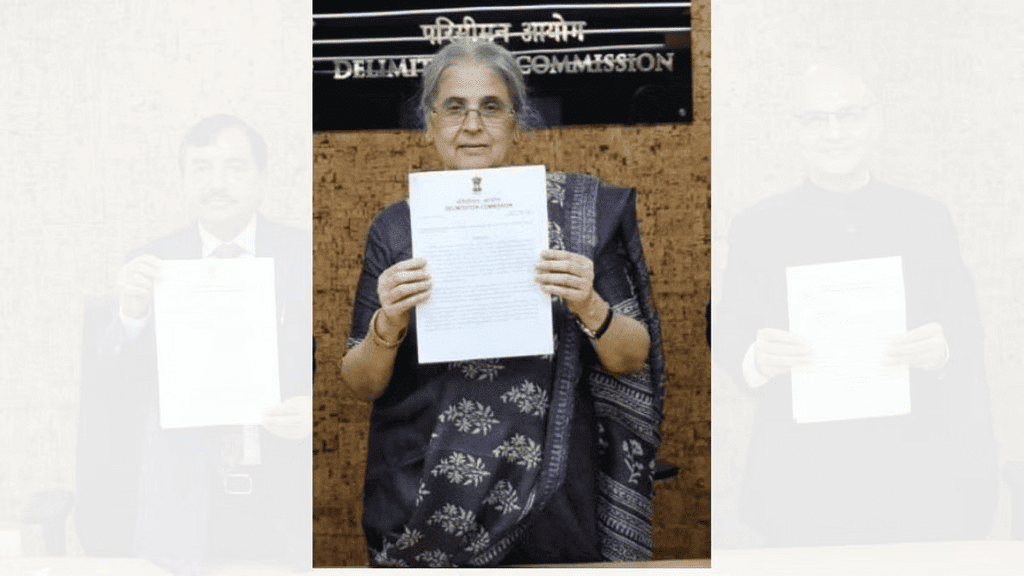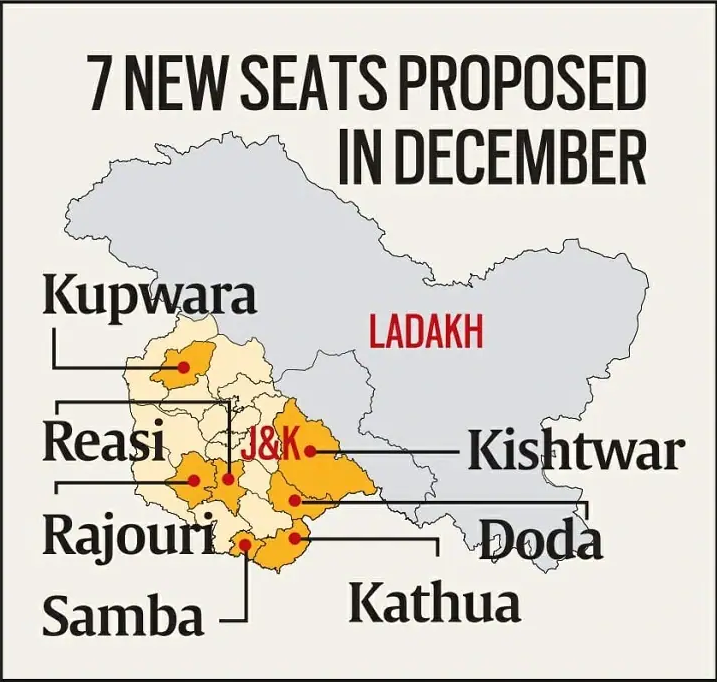Laxmikant Summary: Delimitation Commission of India | Indian Polity for UPSC CSE PDF Download
In India's parliamentary system, there are two important things: delimitation and elections. Delimitation means deciding the boundaries for voting areas.

This is crucial for a few reasons.
- Free and Fair Elections: A key feature of a true democracy is the conduct of free and fair elections. Parliamentary democracy allows people to choose their representatives through the electoral process. Delimitation plays a crucial role in ensuring fair elections by periodically adjusting electoral boundaries.
- Legal Mandate and Norms: The delimitation process follows rules and accepted standards to make sure it aligns with democratic principles. It involves regularly deciding the boundaries for voting areas, following the law in systems where each area elects one representative.By drawing electoral boundaries periodically, the system complies with legal requirements in representative systems using single-member constituencies.
- Complexity and Sensitivity: Delimitation is a complex matter that needs to handled carefully. It forms the foundation for the democratic exercise of public representation through elections.It's like the groundwork for democracy, where people choose their representatives through voting. Creating a group to manage public matters is tied to the idea of representing specific areas, making delimitation a very important step.
- Reflecting Changing Realities: Theoretically, delimitation serves as a stepping stone for adapting the body politic to changing ground realities. Periodic exercises are important to ensure that electoral boundaries accurately reflect shifts in population and demographics over time.

- Principle of One Man, One Vote: The idea in democracy is that every person's vote should be equally important. But making it perfectly equal is hard. Delimitation helps with this by adjusting voting areas depending on how many people live there. This way, even if some places have more or fewer people, the representation becomes more balanced.
In simpler words, delimitation is the process of adjusting electoral boundaries to make sure that elections are fair, reflecting changes in the population over time. It's a legally mandated and periodically conducted exercise crucial for maintaining the principles of democracy, where people can choose their representatives through a balanced and representative electoral system.
Commissions
The Delimitation Commission of India is a powerful and official body established by the Central Government under a law passed by Parliament. Its main job is to mark out the boundaries of Parliament, Rajya Sabha, and Assembly Constituencies across the country.
 Parliament of India
Parliament of India
This commission holds significant authority as its decisions carry the weight of the law, and they cannot be legally challenged in any court. Once the President of India specifies a date, the commission's orders come into effect. These orders are then presented before the Lok Sabha and the respective State Legislative Assembly. However, neither of these bodies can make changes or modifications to the commission's decisions.
Constitutional Provisions
Articles 81, 82, 170, 330, and 332 of the Constitution of India deal with the delimitation of Parliamentary and Assembly Constituencies. These articles were changed by the 84th Constitutional Amendment Act of 2001 and the 87th Constitutional Amendment Act of 2003.

The combined impact of these amendments is as follows:
- The total number of seats in the Lok Sabha allocated to states based on the 1971 census will stay the same until the first census after 2026. Similarly, the total number of seats in the Legislative Assemblies of all states, fixed based on the 1971 census, will also remain unchanged until the first census after 2026.
- The number of seats reserved for Scheduled Castes and Scheduled Tribes in the Lok Sabha and State Legislative Assemblies will be recalculated based on the 2001 census.
- Each state will be redefined into territorial parliamentary and assembly constituencies based on the 2001 census. The boundaries set during this delimitation will remain unchanged until the first census after 2026.
- The redefined constituencies will aim to have a similar population (based on the 2001 census) for each parliamentary and assembly constituency within a state, to the extent possible.
Fourth Delimitation Commission
The Parliament enacted a law in 2002 called the Delimitation Act. This law set up a group called the Delimitation Commission. According to the Constitution and the 2002 Delimitation Act, this Commission's job was to rearrange the voting areas (constituencies) for both Parliament and Assembly in all states of India (except the former state of Jammu and Kashmir). They did this based on the population data from the 2001 census.
The Fourth Delimitation Commission of 2002 was a three-member body. It consisted of the following:
- The Chairperson who was to be either a serving or a retired judge of the Supreme Court. In this case, Justice Kuldip Singh, a retired Supreme Court judge, was appointed as the Chairperson.
 Justice Kuldip Singh
Justice Kuldip Singh - The Chief Election Commissioner or an Election Commissioner nominated by the Chief Election Commissioner was an ex-officio member.
- The State Election Commissioner of the concerned State or Union Territory was the other ex-officio member.
Additionally, the Commission had ten associate members in respect of each state. Out of them, five were members of the Lok Sabha elected from that state, and another five were members of the State Legislative Assembly. Where the number of members of the Lok Sabha in a state was less than five, all such members were associate members for that state. These associated members were nominated by the Speakers of the Lok Sabha and State Legislative Assemblies concerned. However, these associated members did not have the right to vote or to sign any order of the Commission.
Implementation of Recommendations
The Delimitation Commission submitted its recommendations in 2007, and the President of India approved the notification for implementing the recommendations in 2008, leading to the redefinition of Parliamentary and Assembly Constituencies.
The recommendations of the Commission did not apply to five states: Assam, Arunachal Pradesh, Manipur, Nagaland, and Jharkhand. The Government of India deferred the delimitation exercise in the four northeastern states and nullified the final order of the Commission for the state of Jharkhand.

The 2009 General Elections for 499 out of 543 Parliamentary constituencies in all states, National Capital Territory of Delhi, and Union Territory of Puducherry were held based on the newly delimited constituencies. However, these adjustments were not implemented in Assam, Arunachal Pradesh, Manipur, Nagaland, Jharkhand, and the erstwhile Jammu and Kashmir.
Delimitation Commission (2020)
- In February 2028, the Indian government cancelled its previous decision from 2008 that had postponed the process of redrawing electoral boundaries (delimitation) in four northeastern states – Assam, Arunachal Pradesh, Manipur, and Nagaland. The earlier delay was due to concerns about potential threats to India's unity, integrity, and public order in these states. The government stated that the security situation had improved significantly, with a decrease in insurgency incidents and overall improvement in law and order.

- As a result, it was considered safe to proceed with the delimitation exercise. In March 2029, the Indian government established a Delimitation Commission specifically for this task in the four northeastern states and the Union Territory of Jammu and Kashmir. The Commission is responsible for redefining the boundaries of parliamentary and assembly constituencies.
- In March 2020, the Government of India set up a Delimitation Commission for the delimitation of Parliamentary and Assembly constituencies in these four northeastern states and the Union Territory of Jammu and Kashmir (UT of J&K).
The election commission consisted of the following:- Justice Ranjana Prakash Desai, a retired judge from the Supreme Court, was appointed as the Chairperson.
- Sushil Chandra, who is the Election Commissioner, was automatically a member by his position.
- The State Election Commissioner of the relevant State or Union Territory was also a member by their position.
- A commission was formed with Justice Ranjana Prakash Desai as the Chairperson and its task was to redraw electoral boundaries in four northeastern states and the Union Territory (UT) of Jammu & Kashmir. Justice Desai's term was initially set for one year, or until further notice, whichever came first.
 Justice Ranjana Prakash Desai
Justice Ranjana Prakash Desai - The commission was given the task to :
- Redraw the electoral boundaries (constituencies) in four northeastern states according to the rules in the Delimitation Act of 2002.
- Redraw the electoral boundaries (constituencies) in the Union Territory of Jammu & Kashmir following the guidelines in both the J&K Reorganization Act of 2019 and the Delimitation Act of 2002.
- In March 2021, the Indian government removed the northeastern states from the commission's responsibilities. Still, the commission's term was extended until March 2022 to continue its work in the UT of J&K. In February 2022, another two-month extension until May 2022 was given.
- The commission also included five members from Lok Sabha representing the UT of J&K, nominated by the Speaker, but they didn't have voting rights.
- The commission completed its task in May 2022, and their report is titled "Delimited Landscape of Union Territory of Jammu & Kashmir."
Delimitation in J&K
Jammu and Kashmir (J&K) underwent a significant change in its political status with the enactment of the J&K Reorganization Act, 2019, which abolished its special status.
Prior to this, the allocation of Lok Sabha seats in J&K adhered to the provisions of the Indian Constitution, while the distribution of seats in the State Legislative Assembly was regulated by both the Constitution of J&K and the J&K Representation of People Act, 1957.

- Pre-2019 Election Arrangements:
- Delimitation exercises in J&K were conducted in 1957, 1966, 1975, and 1995, with the last one being based on the 1981 census.
- Notably, there was no census in 1991, and after 2001, a legal provision imposed a freeze on any fresh delimitation until figures from the first census after 2026 were made available.
- At that time, the J&K Assembly comprised 111 seats, including 4 in Ladakh, and reserved 24 seats for regions under Pakistan's occupation.
- Post-2019 Changes:
- The J&K Reorganization Act, 2019 led to a significant transformation, converting J&K into a Union Territory (UT) and defining a Legislative Assembly with 114 seats.
- A notable provision empowered the Lieutenant Governor to nominate two women members if there was inadequate representation.
- Despite the changes, 24 seats continued to be reserved for areas under Pakistan's occupation, and these were excluded during the delimitation process.
- Delimitation Commission's Role:
- The current Delimitation Commission, operating under the framework of the J&K Reorganization Act, 2019, and the Delimitation Act, 2002, was entrusted with the task of delineating parliamentary and assembly constituencies in the UT of J&K.
- The delimitation was based on the 2011 census, reflecting a substantial increase in population since the last exercise in 1981.
- Reserved Seats Determination:
- In accordance with constitutional provisions (Article 330 and Article 332), the J&K Reorganization Act, 2019, and the Delimitation Act, 2002, the number of seats reserved for Scheduled Castes (SCs) and Scheduled Tribes (STs) in the Legislative Assembly was calculated based on the 2011 census.
- An interesting point to note is that the previous Constitution of J&K did not incorporate provisions for reserving seats for Scheduled Tribes.
Order of the Commission
In May 2022, the Commission finished deciding the borders for Parliament and Assembly seats in Jammu and Kashmir, which is now a Union Territory.
- J&K Treated as a Single Entity: The Commission considered J&K as one whole unit for this purpose. As a result, all 5 Parliamentary constituencies now consist of an equal number of 18 Assembly Constituencies each.
- New Constituency Created: Anantnag-Rajouri Parliamentary Constituency was formed by merging Anantnag in the Kashmir region with Rajouri & Poonch in the Jammu region.

- Regional Distribution: Out of the total 90 Assembly constituencies in J&K, 43 are allocated for the Jammu region, and 47 are designated for the Kashmir region.
- Introduction of New Constituencies: 6 new Assembly constituencies were created for the Jammu region, and 1 new Assembly constituency was established for the Kashmir region.
- Reserved Seats: To ensure fair representation, 9 Assembly constituencies were reserved for Scheduled Tribes (STs). Out of these, 6 are in the Jammu region, and 3 are in the Kashmir region.
- Seats Reserved for SCs: Additionally, 7 Assembly constituencies were reserved for Scheduled Castes (SCs) to address representation concerns.
- Changes in Constituency Names: The Commission also modified the names of some Assembly constituencies, including one named "Shri Mata Vaishno Devi", reflecting the cultural significance of the region.
Recommendations of the Commission
During a public hearing, the Commission heard from Kashmiri migrants and displaced individuals from Pakistan-occupied Jammu and Kashmir (PoJ&K). The Kashmiri migrants shared that they had faced persecution and were living as refugees in their own country for the past thirty years. They requested the Commission to reserve seats for them in the Jammu and Kashmir Assembly and Parliament to safeguard their political rights. Similarly, the displaced persons from PoJ&K also asked the Commission to allocate a few seats in the J&K Assembly for their representation.

The Commission suggested the following recommendations to the Central Government:
For Kashmiri Migrants: Ensure representation of at least two members from the Kashmiri migrant community in the Jammu and Kashmir Assembly. One of these members should be a woman. These members would have powers similar to those of nominated members in the Assembly of the Union Territory of Puducherry.
For Displaced Persons from PoJ&K: The Central Government should consider providing representation for displaced persons from Pakistan-occupied Jammu and Kashmir (PoJ&K) in the Jammu and Kashmir Assembly. This could be achieved by nominating representatives of the displaced persons from PoJ&K to ensure their voice and presence in the legislative body.
|
170 videos|999 docs|259 tests
|
FAQs on Laxmikant Summary: Delimitation Commission of India - Indian Polity for UPSC CSE
| 1. What is the purpose of the Delimitation Commission in India? |  |
| 2. What are the constitutional provisions regarding the Delimitation Commission? |  |
| 3. What is the role of the Fourth Delimitation Commission? |  |
| 4. How are the recommendations of the Delimitation Commission implemented? |  |
| 5. What is the significance of the 2020 Delimitation Commission in J&K? |  |
















